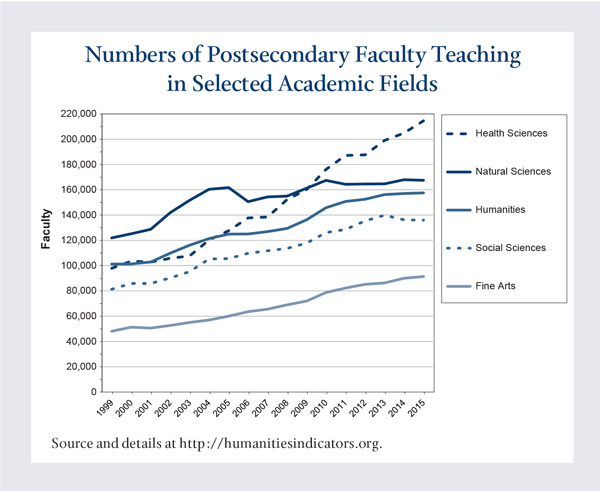The humanities face a variety of challenges in higher education, as reflected both in declining numbers of college majors and in openings for new faculty, according to recent findings from the Humanities Indicators.
Dozens of commentators have cited the number of college degrees in the humanities in recent years as a key metric for the health of the field, and the latest trends can only add to their worries. The number of new bachelor’s degrees in the humanities fell 7.1 percent from 2012 to 2014 (http://bit.ly/HIBAs). The decline was particularly notable among the largest humanities disciplines (languages and literatures, history, and philosophy), which fell to their lowest recorded share among new bachelor’s degrees (6.1 percent) in 2014 (in data that extend back to 1948).
The number of master’s degrees awarded in the humanities from 2012 to 2014 also fell by more than 7 percent (http://bit.ly/hiadvancedD). Here again, as a share of all degrees conferred at this level, the humanities disciplines fell to a historic low (3.1 percent) in 2014.
One potential bright spot in the most recent data was the continued increase in the number of associate’s degrees requiring substantial training in the humanities. The number of such degrees rose to 347,735 in 2014–nearly double the number of bachelor’s degrees in the humanities (http://bit.ly/HIAssocD) conferred in 2014.
The number of doctoral degrees conferred in the humanities in recent years has been steady or rising slightly, but that might be seen as worrisome news, depending on one’s view of job prospects in academia. A new survey of primarily academic jobs advertised through the major humanities disciplinary societies found openings down more than 30 percent in every discipline from pre-recession levels (http://bit.ly/HumJobs16). In 2015, available openings fell in every discipline.
 |
| Source and details at http://humanitiesindicators.org. |
While the number of job advertisements has been falling, the number of humanities faculty employed in the nation’s colleges (both two- and four-year) and universities expanded slightly in recent years. From 2013 to 2015, almost every humanities discipline experienced some growth in its number of faculty members. However, the trend marks a substantial diminution in growth rates seen through the 2000s, and is a striking contrast to the continued increase in the number of faculty members in health science fields.
While the trends in college majors and faculty hiring may be worrisome, other recent updates at the Indicators offer some positive news about the field. As of 2013, the number of new academic publications released in the humanities rose to the highest level in at least five years (http://bit.ly/HIAcadPubs), and research funding support for the humanities was 75 percent higher in 2014 than in 2005 (the first year in which reliable data of this kind were collected; http://bit.ly/HIRschSupp).
While higher education remains a core area of interest for the Humanities Indicators, the project takes a holistic approach to the field. Other recent updates have ranged from reading skills and practices in schools and in the general public to visits to art museums and historic sites. For more information about the Humanities Indicators, please visit http://humanitiesindicators.org or sign up for email updates at http://bit.ly/IndicatorsUpdates.